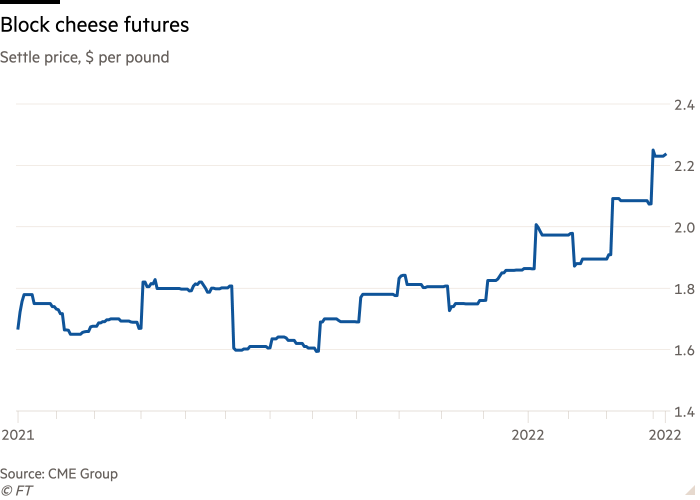It is a bad time to be a cheese lover. Supply shortages and inflation have sent prices soaring for everything from mild cheddar to pungent Camembert. The commodity is now so precious that it has become a tempting target for thieves. Recently, robbers made off with 1,600 kilos of cheese worth $23,000 from a dairy farm in the Netherlands.
The US benchmark price for cheese, akin to a barrel of West Texas Intermediate for oil, is set by 40-pound blocks of cheddar trading on the Chicago Mercantile Exchange. These are trading about $2.23 a pound, a third higher since the start of 2021.

In Europe, prices for mozzarella have gone up by about 44 per cent since November according to the EEX Weekly European Cheese Indices, based upon price contributions from physical dairy market participants. UK cheddar prices have climbed 55 per cent higher over the past two years, while blue cheese in France has gained by a fifth, says Tridge, a food and agricultural products data analytics provider. Wallace and Gromit, the cheese-loving protagonists of several Aardman animations, would surely disapprove.
Tight milk supply has driven cheese prices higher. Steep feed and fuel prices have also squeezed cheesemakers. Anhydrous milk fat, a core dairy product, hit a record $7,111 a tonne on March 15, according to Global Dairy Trade index, which monitors New Zealand dairy prices. Whole milk powder, the most actively traded product, hit an eight-year high last month.

The problem of organised cheese bandits is not new. In Italy, where Parmesan cheese can act as bank collateral. Thieves prize the variety for its high price and the ease with which durable wheels of Parmesan can be moved. The last big heist was in 2018, when criminals stole 271 wheels of organic cheese, weighing 12,500 kilos and worth $300,000. Two years earlier in Wisconsin, a thief made off with a truck holding 10,000 kilos of cheese.
Once stolen, the wheels often get cut up into smaller pieces that cannot be traced. Much of the cheese is thought to end up abroad, including eastern Europe.
An oft-cited study from 2011 claimed that the most stolen food item in the world is cheese. “The reasons why are reasonably clear, including high demand, easy ‘disposal’ by thieves and small, mobile formats that make it easy to conceal,” the report said. Other items may have lured more criminal attention since. But cheesemakers, given the surge in value, would be wise to reinforce their security measures.

